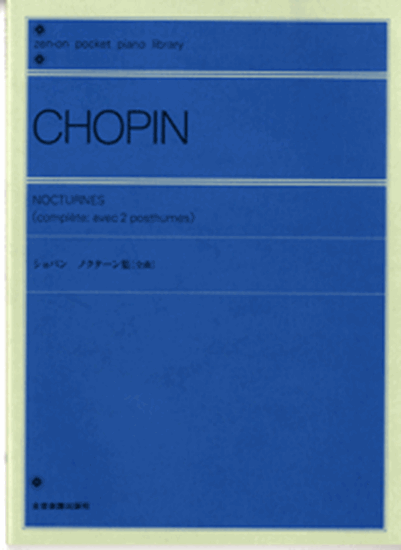Chopin, Frederic : Nocturne No.7 cis-moll Op.27-1
Work Overview
Genre:nocturne
Total Playing Time:5 min 00 sec
Copyright:Public Domain
Commentary (2)
Author : Higuchi, Akiko
Last Updated: February 9, 2019
[Open]
Author : Higuchi, Akiko
Deux nocturnes op. 27
These two nocturnes were composed in 1835, and their first editions were published in Paris (M. Schlesinger, 1836), Leipzig (Breitkopf und Hartel, 1836), and London (Wessel, 1836). They are dedicated to Countess d'Apponyi, wife of the Austrian Ambassador to France. Due to their dedication to a lady of high social standing, they are sometimes referred to as "Nocturnes for a Lady." Although grouped as a pair, the musical character of these two pieces presents a striking contrast, as if to complement each other.
No. 1 C-sharp minor
This nocturne, like other nocturnes, consists of three sections (A - B - A'). In sections A and A', the left hand's arpeggiated sextuplets, which constantly play the accompaniment figure, possess a very wide range, extending over two octaves by measure 13. Such smooth movement across a wide range was made possible by improvements in the damper pedal (sustain pedal).
At the beginning, following an introduction with a characteristic sound of an empty fifth (C-sharp, G-sharp) lacking the third (E), a chromatically wandering theme is presented in the right hand. The brilliant ornamentation seen in the theme's repetitions in earlier works like Op. 9 No. 2 (the second) and Op. 15 No. 2 (the fifth) is entirely absent in this piece. Instead, when the theme is repeated, two voices are added to the right-hand melody, transforming it from a "solo" to a "duet." The melody is very simple and less undulating compared to other nocturnes, but it blends beautifully with the accompaniment figure through the use of the damper pedal. From measure 29, the atmosphere shifts dramatically, entering the dramatic middle section B (measures 29-83). With short two-measure phrases, insistent repeated notes, and a 20-measure passage of ascending dotted half-note scales and semitone tremolos in the left hand, both the range and dynamics are rapidly expanded, reaching a climax once at measure 46. From measure 53, chromatic progression reappears, bringing one scene of the middle section to a close. At measure 67, a mazurka appears, similar to Op. 15 No. 3 (the sixth), but the dance does not last long, being evaded by chromatic modulations and interrupted by a powerful series of chordal repetitions at measure 81. The use of such mazurkas in nocturnes from the 1830s can be interpreted as an expression of nationalistic sentiment stirred by the November Uprising that erupted in 1830. Just before the return of the theme, within a long fermata, the left hand plays a highly recitative-like passage in octaves.
A' is a significantly condensed form of A, and at measure 94, it modulates to the parallel major, C-sharp major; the section from this point onward can also be regarded as a coda. Both volume and tempo gradually decrease, moving towards Adagio, and the piece concludes in C-sharp major.
Author : Ooi, Kazurou
Last Updated: March 12, 2018
[Open]
Author : Ooi, Kazurou
No. 7, Op. 27-1, C-sharp minor
This Nocturne has a peculiar structure. Its tonality and form are distinctive. It is crucial to note that the build-up to reaching the peak point is written to be exceptionally extended, and performers are prone to losing tension. Discern where the climax lies and proceed accordingly. Furthermore, this Nocturne contains truly tricky elements. Let's examine the score immediately.
Although the key signature is C-sharp minor, the piece begins with the crucial third omitted. The third is more important than the fifth in determining whether a chord is major or minor, and its absence creates a truly mysterious opening. This is because it is unclear what key it is in, and this remains unclear until measure 11. For instance, measure 7 might initially suggest E major. However, such writing can also be seen in Op. 10, No. 12, where it also takes quite a while to discern the key at the beginning.
Therefore, measure 11 can be emphasized to clarify that the key is C-sharp minor. The melody line also introduces octaves for the first time here. The first phrase concludes at measure 18, and from measure 19, a variation begins, but with the exact same melody line.
Now, from measure 29, the B section begins, marking the start of the ascent to the peak point. From here, maintain tension until measure 81. When entering the B section, be careful not to make the timing unnatural. Although "piu mosso" is indicated, do not change the tempo abruptly; instead, match the speed of the triplets to that of the sextuplets in the A section, and gradually accelerate for a smoother entrance. First, build a crescendo up to measure 49, which is the initial focal point. Play restlessly, in an "agitato" manner. Observe "sempre piu stretto" indicated at measure 41. Play measure 45 "appassionato" and measure 50 "sostenuto", adhering to each indication.
Of course, the dynamics decrease at measure 52, but the tension must be sustained. The indication is "agitato", and the left-hand figuration perfectly depicts this. At measure 83, there is a significant cadenza. In any case, it is crucial not to lose focus until this point. Since there is a succession of "stretto", "piu mosso", and "accel", the measures leading up to the cadenza, such as 81-82, will ultimately become extremely fast.
This is a psychological depiction of the human mind reaching its limits, and it is profoundly serious. This tension must be conveyed to the audience, and it should overwhelm them in the B section.
PTNA & Partner Channel Videos(2items)
Sheet Music
Scores List (12)

(株)全音楽譜出版社

ハンナ(ショパン)

(株)ドレミ楽譜出版社

(株)音楽之友社

(株)全音楽譜出版社

(株)音楽之友社

(株)全音楽譜出版社

(株)全音楽譜出版社

(株)全音楽譜出版社

ポーランド音楽出版社

(株)ヤマハミュージックエンタテインメントホールディングス

(株)音楽之友社



![ノクターン[夜想曲] 第7番 - 演奏動画のサムネイル](http://i.ytimg.com/vi/1pOdHlpuiVo/mqdefault.jpg)